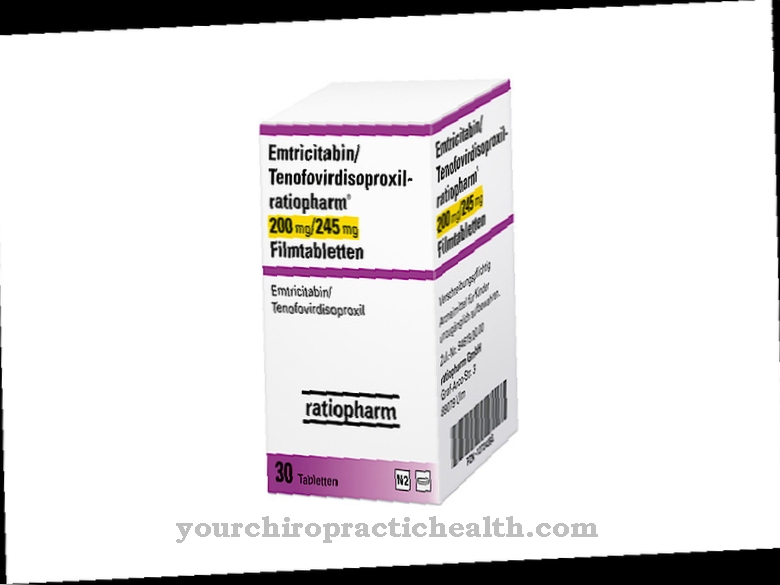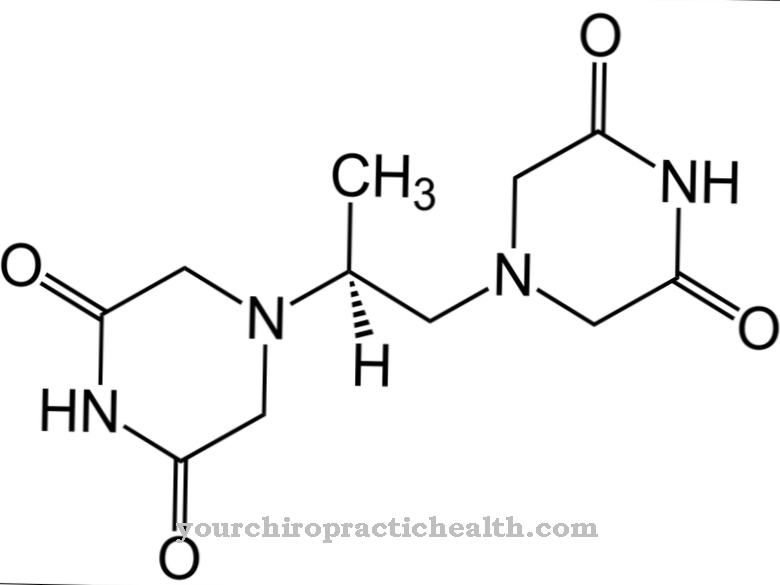As Sucralfate is the name of a drug that is used to treat stomach and duodenal ulcers. The agent builds up a protective layer on the mucous membrane of the upper digestive region.
What is sucralfate?
Sucralfate is an aluminum salt of sucrose sulfate. In medicine, the active ingredient is primarily used to treat gastric ulcers (ulcus ventriculi). It is also suitable for the treatment of duodenal ulcers.
Sucralfate was approved in Europe in the mid-1980s. In Germany, the drug is administered under the product names Sucrabest® and Ulcogant®. There are also various generics of the basic aluminum sucrose sulfate on the market.
Pharmacological effect
Sucralfate belongs to the group of acid-binding drugs. It has the ability to neutralize excess stomach acid by binding. In this way it is possible to prevent illnesses caused by acids.
Because of its special mode of action, sucralfate has a special position among the acid-binding preparations. The agent can combine with proteins from gastric mucus and gastric mucosa, which in turn creates a protective layer on the surface of the damaged mucous membrane. This protective layer can counteract further damage to the mucous membrane caused by stomach acid, bile and stomach enzymes. This already indicates another property of sucralfate: the binding of gastric enzymes such as pepsin and bile acids.
Sucralfate promotes the production of prostaglandins, which are the body's own substances. They ensure an increased production of the mucous membrane within the gastrointestinal tract. This protective layer is of great importance for protecting the mucous membrane from gastric acid.
The absorption of sucralfate occurs to a small extent. This means that most of the active ingredient is excreted from the organism without any changes. The drug can exert its effect in an acidic environment. This creates a jelly-like coating on the stomach lining.
Medical application & use
The most common use of sucralfate is in the treatment of gastric and duodenal ulcers. The drug is also suitable for the prevention of these diseases. It is usually used in the early stages to protect the gastric mucosa. However, sucralfate is not used permanently, as more effective drugs such as proton pump inhibitors are available for this purpose.
Another indication is the therapy of an esophagitis, which is triggered by gastric acid flowing back. However, sucralfate is not suitable for use if there is a malignant gastric ulcer or an infection with the Helicobacter pylori bacterium.
Sucralfate can also be given for external use. It is used as a component of various wound healing creams.
Sucralfate is given either in tablet form, as granules or as a suspension. The recommended daily dose is 1 gram. It is taken one hour before a meal and before going to bed. In this way, the effect of the medicinal substance unfolds in an acidic environment. The dosage also depends on whether it is a gastric ulcer or a duodenal ulcer.
Risks & side effects
The use of sucralfate can be associated with undesirable side effects in some patients. This primarily includes constipation (constipation). Other possible side effects are dry mouth, feeling of fullness, nausea or dizziness. If kidney function is impaired, the aluminum concentration in the body may increase. In rare cases, patients also have an itchy rash on the skin. If the described side effects occur, it is advisable to ask a doctor or pharmacist for advice.
Sucralfate must not be used at all if the patient is hypersensitive to drugs that contain sucralfate. Careful assessment of the risks and benefits of treatment must be made when there is severe renal impairment. There is a risk of a dangerous build-up of aluminum contained in the active ingredient.
Sucralfate should only be used during pregnancy if absolutely necessary. In this way, the aluminum can also accumulate in the bones of the unborn child. This accumulation threatens the baby with damage to the nerves.
Although the aluminum contained in sucralfate can penetrate into breast milk, a short-term administration of the agent during breastfeeding is considered harmless. So there is only a slight absorption of aluminum within the child's body. Possible alternatives should nevertheless be weighed up. The use of sucralfate in children under 14 years of age is not recommended. There are not enough studies on this age range.
By taking sucralfate and other drugs at the same time, interactions are possible. For example, antibiotics such as colistin, amphotericin B or tobramycin, the bile drugs ursodeoxycholic acid and chenodeoxycholic acid, the anti-fungal drug ketoconazole, the antiepileptic phenytoin, the thyroid hormone levothyroxine and the acid blockers ranitidine and cimetidine are reduced in their effectiveness. For this reason, there should be an interval of at least two hours between using sucralfate and these drugs.
It is also suspected that sucralfate has negative effects on anticoagulant medicines. Therefore, the attending physician controls the dosage of these active ingredients very carefully if they are taken at the same time. When sucralfate is given with medicines containing potassium sodium hydrogen citrate, this often leads to an increased intake of aluminum.



























